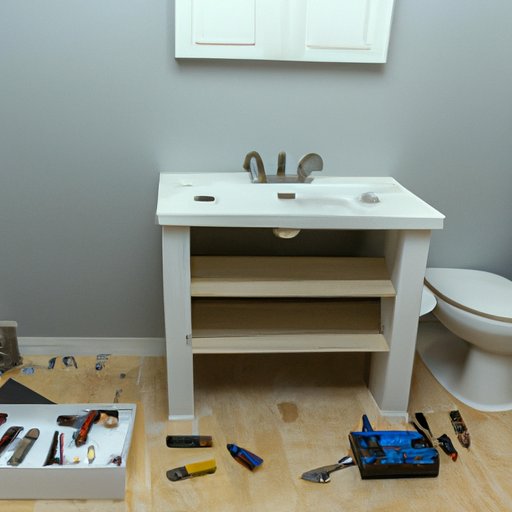
I. Introduction
Installing a bathroom vanity may seem like a daunting task, but with the proper guidance, it can be a straightforward project that can significantly enhance a bathroom’s aesthetic and functionality. This article is designed to provide step-by-step instructions on installing a bathroom vanity, as well as tips on how to avoid potential challenges and mistakes. The primary target audience for this article is homeowners or DIY enthusiasts looking to upgrade their bathroom’s look and feel.
II. Step-by-Step Instructions
Before beginning the installation process, it is crucial to ensure that you have all the necessary tools and materials, including a level, measuring tape, drill, screws, plumbing tools, and the desired vanity and countertop. The following are the general steps to follow:
1. Preparing the area
The first step is to remove the old vanity and clean the area. Ensure that all pipes and electrical outlets are adequately protected, and shut off the water and electrical supply as necessary.
2. Measuring and marking the vanity’s placement
Measure the space where you intend to place the vanity, taking note of any pipes or uneven flooring that may require modifications. Use a level and a pencil to mark the position of the vanity and its corresponding measurements.
3. Installing the cabinet and countertop
Begin by securing the vanity to the wall using screws, ensuring that it remains level. Attach the countertop to the cabinet, securing it with adhesive or screws as necessary. Check that the countertop is level, and make any necessary adjustments.
4. Connecting the plumbing
Begin by installing the new faucet and drain components on the sink, and then follow the manufacturer’s instructions for connecting any required plumbing components. Be sure to double-check all connections to prevent leaks.
5. Securing the vanity to the wall
After connecting the plumbing components, secure the vanity to the wall again, ensuring that it remains level. Use shims to adjust any unevenness in the floor and wall if necessary.
Of course, the process may be more straightforward or more complicated depending on the specific vanity and bathroom in question, as well as the DIY experience level. Make sure to follow the instructions that come with the specific product and to take the time to ensure each step is successful.
III. Video Tutorial
Although the written instructions can be helpful, a video tutorial can offer a more comprehensive guide by giving a visual representation of the installation process. A visual aid can be particularly helpful for those who prefer a more hands-on approach to learning. This video can show the process from start to finish, providing clarity on any confusing steps in the written guide.
IV. Pros and Cons
While installing a bathroom vanity on your own can be a satisfying experience, it is essential to weigh the pros and cons before making the decision. Here are some to consider:
Pros
- Installing the vanity yourself can save money on labor costs, which can be significant for a home renovation budget.
- It can be an enjoyable DIY project that provides a sense of accomplishment.
- You can choose a vanity and a countertop that fits your specific tastes, style preferences, and bathroom layout.
Cons
- The process can be challenging, time-consuming, and requires technical skills and knowledge.
- If done incorrectly, it can lead to serious plumbing and electrical problems that can cause damage to your home.
- It requires access to specialized tools that may not be available to the average homeowner.
Ultimately, the decision to DIY or not depends on your experience level, the complexity of the installation, and your willingness to learn new skills. For larger or more complicated projects, it may be best to hire a professional to avoid potential damages and accidents.
V. Common Mistakes
Even with the best intentions and preparation, mistakes can happen during the installation process. Here are some common mistakes to avoid:
- Improper measurements, resulting in a vanity that does not fit or is not level.
- Inaccurate cuts in the countertop or the cabinet, leading to an uneven surface.
- Incorrect plumbing connections, leading to leaks and potential water damage.
- Forgetting to connect the P-trap, which can lead to unpleasant odors and clogs.
Always double-check the measurements, read the instructions carefully, and take your time when making cuts and installing plumbing components. Consider asking a friend or family member with more DIY experience to assist you if possible.
VI. Product Recommendations
Choosing the right bathroom vanity can make all the difference in your bathroom’s aesthetic and functionality. Here are some of our top picks:
- AMARE 72″ Wall-Mounted Double Bathroom Vanity Set with Vessel Sinks: this modern set features a double sink and ample storage space, giving it both style and functionality.
- MODERO 60″ Double Vanity White Carrera Marble Top: this set includes a marble countertop and a classic design, making it a perfect choice for traditional bathroom styles.
- CAROLINE 48″ Single Vanity White Marble Top: this elegant white marble single vanity is perfect for a smaller bathroom.
When choosing your vanity, consider factors such as size, style, and functionality to find the best fit for your bathroom.
VII. Conclusion
Installing a bathroom vanity is a significant home improvement project that can enhance your bathroom’s look and feel. By following the step-by-step instructions carefully, avoiding common mistakes, and selecting the right vanity, you can complete the project successfully. However, if you don’t feel confident in your DIY skills, or if the project is too complex, consider seeking help from a professional.
Remember always to double-check your measurements, connections, and alignment and to take the time to familiarize yourself with the steps before beginning. With persistence, careful attention to detail, and the right tools and resources, you can complete a beautiful bathroom vanity installation that you can be proud of.




